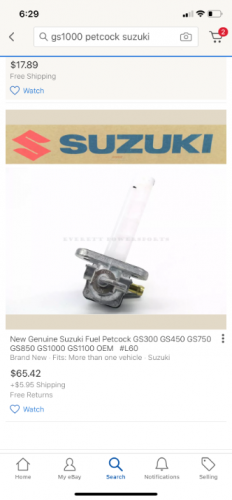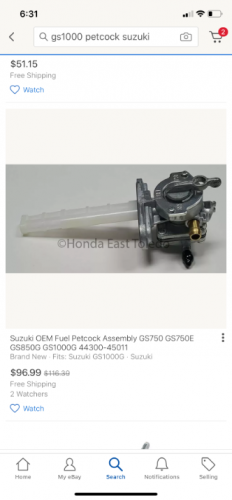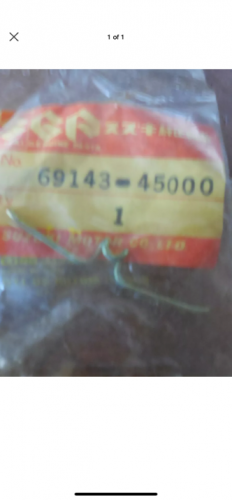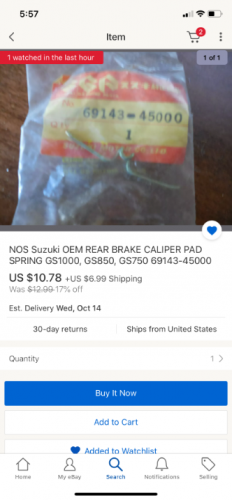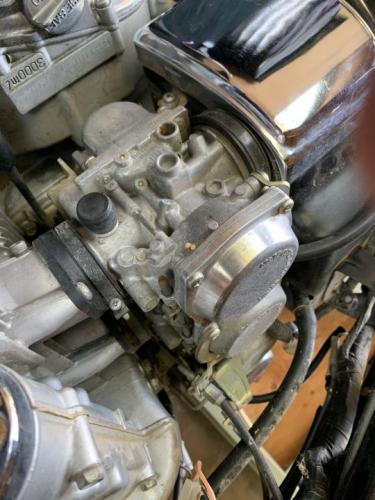

RickLee
Members-
Posts
171 -
Joined
-
Last visited
Content Type
Profiles
Forums
Events
Everything posted by RickLee
-
The interchangeability will be a big plus... this is good knowledge. Thanks.
-
In the past petcocks seemed to be a simple fix.... not so much anymore unless we shell out the bigger bucks. Below is the picture of an aftermarket petcock that looks promising. Then another OEM that’s expensive. The OEM petcock has the feed and vacuum lines on the correct side. All of the aftermarket I’ve seen have the feeds on the wrong side.
-
I’m not as concerned about the 11.00 price but the 6.99 shipping cost irks me. You could literally put this in an envelope with a single postage stamp for 60 cents
-
Does anyone here know where I can find some Gs 750-1000 brake caliper springs for the rear pads? Tiny little springs .... found only one single spring on Eblag for 0utrageous shipping price. Or... has anyone found an alternative spring clip? thanks.
-
The cheap Eblag petcock have a diaphragm that is made of much much thinner rubber sheet than the original equipment. The corners of this cheap diaphragm where the 4 screws go.... the screw holes are so close to the edge of the corner that they tear right out under the vacuum of any bike larger than a 650. I got the guy who sold me one to apply a refund. Im not so sure a GS 750-1000 can run optimally with a straight feed without the vacuum actuated diaphragm. I could be wrong, but I’m going to step up and find the OEM parts. like a lot on this thread I’m dealing with a bike that had been sitting for god knows how long. I know it starts and sounds good cuz I was able to do that before the diaphragm popped. I just can’t ride it yet due to dangerous issues like brake restoration, cracked tires, dirty gas tank, loose crap and many other incidentals. if anyone ever finds a real good replacement petcock that works vacuum Wise like the original for a GS1000 please direct me there. Otherwise original Suzuki rebuild kit and petcock filter replacement ( mine is broken ) ... Thanks and good luck with these old monsters. They are fun but lots of issues being42 years old and sitting.
-
Thanks, I spent 3 weeks off and on cleaning the tank. I’m confident it will be good without a sealer. The bike has an in-line Fuel filter on it.... looks clean. Funny thing is it was running fairly well and didn’t start leaking gas out of the carbs until I shut down the motor. Then all hell broke loose. I was thinking about fire lol. I will give the carbs a good cleaning.
-
The bike has been sitting quite a long time. Until I get a little more money to put into it, could I drop the bowls and clean and make sure the floats are not stuck? This morning I took the diaphragm out of the old petcock and slid it into the aftermarket petcock. It fit very well and the rubber is much thicker. Seems to be working fine now. The reason I’m not using the old original petcock is because the filter had been broken off for some reason. The old original petcock is full of sludge. Can these petcock filters be removed and replaced if I decide to rebuild the old one!
-
Not the answer I was hoping for obviously but you are most likely correct. I was hoping I would not have to go into the carbs but it’s an old bike and I have all winter. Thanks gsxr
-
I bought an aftermarket petcock for my 1981 GS 1000 that is supposed to vacuum feed fuel when the bike is running, and shut off the flow when the bike stops running. Well it seems that when the bike is off, it keeps flowing anyway. I took off the tank and tried the three positions on the petcock... there is no off... it flows in all three positions. I’m aware that the on position is supposed to be on only when the bike is running and producing vacuum, and off when not producing vacuum. The prime and reserve are not supposed to be off positions. the problem is that the carbs filled up and emptied gas into my air box... lots of it. Should the floats have stopped this from happening or is the pressure from the flowing fuel pushing its way through ? I’ve ordered another petcock but in the meantime is there a way I can make this faulty one work in only an on and off position? I read a thread where someone put a piece of rubber where the diaphragm goes and got it to somehow do an off and on position. Any details on this Temporary “fix” would also be appreciated. Thanks All!
-
Probably better listen to Gixer1460.... sounds like he’s had Real world experience w/ this. Racing’s not my bag man.... As Austin powers would say.
- 25 replies
-
- 1
-

-
I should have paid closer attention to the compression ratio in your original post. But to be truly honest I’m not sure about composite factory gaskets at that ratio. I’d say go for it but depending on how often and how hard your going to run it. I’d also make sure the head torque is perfect. There is a copper gasket sealer that I’ve used on headers. But that would be just an experiment on your bike.
- 25 replies
-
Copper gaskets a waste of time and labor, Reinhoud is right, always find stock factory gaskets if you can. They work!
- 25 replies
-
When you get a load of the price of NEW calipers.... wow. Are there any reasonably priced aftermarket calipers for 1980 GS1000?
-
I was also told that honing those caliper cylinders is not a great idea, just a very meticulous cleaning and scraping off the hardened hunk carefully... Does anyone else agree with this? Or is it ok to hone these?
-
I’m new here too and just got a 80 GS1000G shaft drive. Similar situation with mine. Sitting a long time outside. Fired right up but brakes frozen. I’m actually looking for a frame with Title because mine doesn’t have a title.
-
Rear brake pedal pivot is usually rusted so tight you need a sledgehammer and a bunch of wd40 to pop it out. Clean it, fine sand and polish it. Same goes for the tube it slides into. Use a long lasting grease before you reinstall. I’m considering drilling a hole and putting a zirk fitting into mine. Took a while to fix this. The rear master. Cylinder is a fairly easy rebuild but the caliper seals and boots are quite difficult. I know from experience. To remove the frozen pistons use compressed air hose with a rubber tip. Be sure to place a piece of wood under the piston or it will pop out like a bullet into your caliper.

